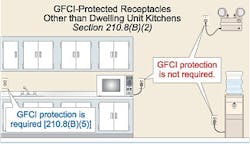All questions and answers are based on the 2008 NEC.
Q. Is GFCI protection required for receptacles above the counter of a break room in an office building?
A. If the break room has a sink and permanent provisions for food preparation and cooking [Art. 100 Kitchen], then all 125V, 15A, and 20A receptacles in the kitchen area must be GFCI protected [210.8(B)].
Q. If we are using self-grounding receptacles with MC cable and metal boxes, do we need to connect the equipment grounding conductor to the receptacle?
A. No. Receptacle yokes listed as self grounding are designed to establish the bonding path between the device yoke and a metal box via the two metal mounting screws [250.146(B)].
Q. Where does the NEC require removal of abandoned line voltage wiring?
A. The only time the NEC requires removal of abandoned line voltage circuit conductors is for cellular concrete floors [372.13], cellular metal floors [374.7], underfloor raceways [390.7], information technology equipment if not installed in a metal raceway [645.5(F)], and temporary wiring [590.3].
Q. How far above a residential garage floor do receptacles need to be located?
A. The Code does not require any specific height for equipment located in residential garages. Receptacles may be mounted as low or as high as you would like them to be.
Q. Do I need to use 20A duplex receptacles for a 20A circuit?
A. No, Table 210.21(B)(3) allows a 15A duplex receptacle on a 20A circuit.
Q. Does the NEC contain torque requirements for conductor terminations?
A. No, except for motor control circuit devices [430.9]. However, it does have a Fine Print Note in 110.14 that states, “Conductors must terminate in devices that have been properly tightened in accordance with the manufacturer's torque specifications included with equipment instructions. Failure to torque terminals can result in excessive heating of terminals or splicing devices (due to a loose connection), which can result in a fire because of a short circuit or ground fault. In addition, this is a violation of 110.3(B), which requires all equipment to be installed in accordance with listing or labeling instructions.”
Q. Can we put multiple Type NM cables through a single knockout?
A. Yes, you can put multiple Type NM cables through a single knockout but only if the termination fitting is listed for the purpose. Most termination fittings are only listed for a single cable connection, but there are some that are listed for two cables [110.3(B) and 312.5(C)].
Q. Can a panel be installed in a bathroom?
A. Maybe. Overcurrent devices must not be located in the bathrooms of dwelling units, or guest rooms or guest suites of hotels or motels [240.24(E)]. Also, the service disconnecting means must not be located in a bathroom, even in commercial or industrial facilities [230.70(A)(2)].
Q. If an appliance is cord and plug connected, is a disconnecting means required?
A. No, a plug and receptacle can serve as the disconnecting means for a cord-and-plug-connected appliance if the plug connection is accessible [422.33(A)].
About the Author

Mike Holt
Mike Holt is the owner of Mike Holt Enterprises (www.MikeHolt.com), one of the largest electrical publishers in the United States. He earned a master's degree in the Business Administration Program (MBA) from the University of Miami. He earned his reputation as a National Electrical Code (NEC) expert by working his way up through the electrical trade. Formally a construction editor for two different trade publications, Mike started his career as an apprentice electrician and eventually became a master electrician, an electrical inspector, a contractor, and an educator. Mike has taught more than 1,000 classes on 30 different electrical-related subjects — ranging from alarm installations to exam preparation and voltage drop calculations. He continues to produce seminars, videos, books, and online training for the trade as well as contribute monthly Code content to EC&M magazine.
